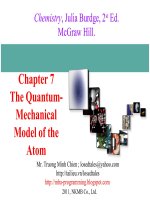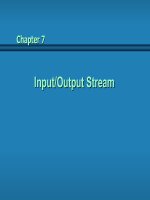Chapter 7 - Sequential Logic Design Principles
Bạn đang xem bản rút gọn của tài liệu. Xem và tải ngay bản đầy đủ của tài liệu tại đây (96 KB, 10 trang )
Section 7.12 VHDL Sequential-Circuit Design Features 549
DO NOT COPY
DO NOT COPY
DO NOT COPY
DO NOT COPY
DO NOT COPY
DO NOT COPY
DO NOT COPY
DO NOT COPY
DO NOT COPY
Copyright © 1999 by John F. Wakerly Copying Prohibited
7.21 Synthesize a circuit for the state diagram of Figure 7-64 using six variables to
encode the state, where the
LA–LC
and
RA–RC
outputs equal the state variables
themselves. Write a transition list, a transition equation for each state variable as
a sum of p-terms, and simplified transition/excitation equations for a realization
using
D
flip-flops. Draw a circuit diagram using SSI and MSI components.
7.22 Starting with the transition list in Table 7-18, find a minimal sum-of-products
expression for
Q2
∗, assuming that the next states for the unused states are true
don’t-cares.
7.23 Modify the state diagram of Figure 7-64 so that the machine goes into hazard
mode immediately if
LEFT
and
RIGHT
are asserted simultaneously during a turn.
Write the corresponding transition list.
Exercises
7.24 Explain how metastability occurs in a
D
latch when the setup and hold times are
not met, analyzing the behavior of the feedback loop inside the latch.
A B
C D
1X′ Y
X
1
(a)
X
•
Y
A B
C D
X′
•
Z
W
X + Y
(b)
W + X
W + Z
X + Z′
A B
C D
X
•
Y
Z X
•
Z′
X′
•
Y′
Z′
(c)
X
•
Z′
X + Y′
X′
•
Y
X
Z
(d)
A B
C D
X
Z
X′
Y′Z′
X′
•
Y′
•
Z′ W′
•
Y′
•
Z′
W′
•
X′
•
Y′ W′
•
X′
•
Z′
W′
W Y
W
•
Z
Figure X7.20
550 Chapter 7 Sequential Logic Design Principles
DO NOT COPY
DO NOT COPY
DO NOT COPY
DO NOT COPY
DO NOT COPY
DO NOT COPY
DO NOT COPY
DO NOT COPY
DO NOT COPY
Copyright © 1999 by John F. Wakerly Copying Prohibited
7.25 What is the minimum setup time of a pulse-triggered flip-flop such as a master/
slave
J-K
or
S-R
flip-flop? (Hint: It depends on certain characteristics of the
clock.)
7.26 Describe a situation, other than the metastable state, in which the
Q
and /
Q
out-
puts of a 74x74 edge-triggered
D
flip-flop may be noncomplementary for an
arbitrarily long time.
7.27 Compare the circuit in Figure 7.27 with the
D
latch in Figure 7-12. Prove that the
circuits function identically. In what way is Figure 7.27, which is used in some
commercial
D
latches, better?
7.28 Suppose that a clocked synchronous state machine with the structure of
Figure 7-35 is designed using
D
latches with active-high
C
inputs as storage ele-
ments. For proper next-state operation, what relationships must be satisfied
among the following timing parameters?
7.29 Redesign the state machine in Drill 7.9 using just three inverting gates—
NAND
or
NOR
—and no inverters.
7.30 Draw a state diagram for a clocked synchronous state machine with two inputs,
INIT
and
X
, and one Moore-type output
Z
. As long as
INIT
is asserted,
Z
is contin-
uously 0. Once
INIT
is negated,
Z
should remain 0 until
X
has been 0 for two
successive ticks and 1 for two successive ticks, regardless of the order of occur-
rence. Then
Z
should go to 1 and remain 1 until
INIT
is asserted again. Your state
diagram should be neatly drawn and planar (no crossed lines). (Hint: No more
than ten states are required).
7.31 Design a clocked synchronous state machine that checks a serial data line for even
parity. The circuit should have two inputs,
SYNC
and
DATA
, in addition to
CLOCK
, and one Moore-type output,
ERROR
. Devise a state/output table that
does the job using just four states, and include a description of each state's mean-
ing in the table. Choose a 2-bit state assignment, write transition and excitation
t
Fmin
,
t
Fmax
Minimum and maximum propagation delay of the next-state logic.
t
CQmin
,
t
CQmax
Minimum and maximum clock-to-output delay of a
D
latch.
t
DQmin
,
t
DQmax
Minimum and maximum data-to-output delay of a
D
latch.
t
setup
,
t
hold
Setup and hold times of a
D
latch.
t
H
,
t
L
Clock
HIGH
and
LOW
times.
Q
/Q
D
C
Figure X7.27
Section 7.12 VHDL Sequential-Circuit Design Features 551
DO NOT COPY
DO NOT COPY
DO NOT COPY
DO NOT COPY
DO NOT COPY
DO NOT COPY
DO NOT COPY
DO NOT COPY
DO NOT COPY
Copyright © 1999 by John F. Wakerly Copying Prohibited
equations, and draw the logic diagram. Your circuit may use
D
flip-flops,
J-K
flip-
flops, or one of each.
7.32 Design a clocked synchronous state machine with the state/output table shown in
Table 7.32, using
D
flip-flops. Use two state variables,
Q1 Q2
, with the state
assignment
A = 00, B = 01, C = 11, D = 10
.
7.33 Repeat Exercise 7.32 using
J-K
flip-flops.
7.34 Write a new transition table and derive minimal-cost excitation and output equa-
tions for the state table in Table 7-6 using the “simplest” state assignment in
Table 7-7 and
D
flip-flops. Compare the cost of your excitation and output logic
(when realized with a two-level
AND
-
OR
circuit) with the circuit in Figure 7-54.
7.35 Repeat Exercise 7.34 using the “almost one-hot” state assignment in Table 7-7.
7.36 Suppose that the state machine in Figure 7-54 is to be built using 74LS74
D
flip-
flops. What signals should be applied to the flip-flop preset and clear inputs?
7.37 Write new transition and excitation tables and derive minimal-cost excitation and
output equations for the state table in Table 7-6 using the “simplest” state assign-
ment in Table 7-7 and
J-K
flip-flops. Compare the cost of your excitation and
output logic (when realized with a two-level
AND
-
OR
circuit) with the circuit in
Figure 7-56.
7.38 Repeat Exercise 7.37 using the “almost one-hot” state assignment in Table 7-7.
7.39 Construct an application table similar to Table 7-10 for each of the following flip-
flop types: (a)
S-R
; (b)
T
with enable; (c)
D
with enable. Discuss the unique prob-
lem that you encounter when trying to make the most efficient use of don’t-cares
with one of these flip-flops.
7.40 Construct a new excitation table and derive minimal-cost excitation and output
equations for the state machine of Table 7-8 using
T
flip-flops with enable inputs
(Figure 7-33). Compare the cost of your excitation and output logic (when real-
ized with a two-level
AND
-
OR
circuit) with the circuit in Figure 7-54.
7.41 Determine the full 8-state table of the circuit in Figure 7-54. Use the names
U1
,
U2
, and
U3
for the unused states (001, 010, and 011). Draw a state diagram and
explain the behavior of the unused states.
7.42 Repeat Exercise 7.41 for the circuit of Figure 7-56.
Ta b l e X 7 . 3 2
X
S
0 1
Z
A B D
0
B C B
0
C B A
1
D B C
0
S
*
552 Chapter 7 Sequential Logic Design Principles
DO NOT COPY
DO NOT COPY
DO NOT COPY
DO NOT COPY
DO NOT COPY
DO NOT COPY
DO NOT COPY
DO NOT COPY
DO NOT COPY
Copyright © 1999 by John F. Wakerly Copying Prohibited
7.43 Write a transition table for the nonminimal state table in Figure 7-51(a) that
results from assigning the states in binary counting order,
INIT
–
OKA1
= 000–110.
Write corresponding excitation equations for
D
flip-flops, assuming a minimal-
cost disposition of the unused state 111. Compare the cost of your equations with
the minimal-cost equations for the minimal state table presented in the text.
7.44 Write the application table for a
T
flip-flop with enable.
7.45 In many applications, the outputs produced by a state machine during or shortly
after reset are irrelevant, as long as the machine begins to behave correctly a short
time after the reset signal is removed. If this idea is applied to Table 7-6, the
INIT
state can be removed and only two state variables are needed to code the remain-
ing four states. Redesign the state machine using this idea. Write a new state
table, transition table, excitation table for
D
flip-flops, minimal-cost excitation
and output equations, and logic diagram. Compare the cost of the new circuit with
that of Figure 7-54.
7.46 Repeat Exercise 7.45 using
J-K
flip-flops, and use Figure 7-56 to compare cost.
7.47 Redesign the 1s-counting machine of Table 7-12, assigning the states in binary
counting order (
S0
–
S3
= 00, 01, 10, 11). Compare the cost of the resulting sum-
of-products excitation equations with the ones derived in the text.
7.48 Repeat Exercise 7.47 using
J-K
flip-flops.
7.49 Repeat Exercise 7.47 using
T
flip-flops with enable.
7.50 Redesign the combination-lock machine of Table 7-14, assigning coded states in
Gray-code order (
A
–
H
= 000, 001, 011, 010, 110, 111, 101, 100). Compare the
cost of the resulting sum-of-products excitation equations with the ones derived
in the text.
7.51 Find a 3-bit state assignment for the combination-lock machine of Table 7-14 that
results in less costly excitation equations than the ones derived in the text. (Hint:
Use the fact that inputs 1–3 are the same as inputs 4–6 in the required input
sequence.)
7.52 What changes would be made to the excitation and output equations for the com-
bination-lock machine in Section 7.4.6 as the result of performing a formal
multiple-output minimization procedure (Section 4.3.8) on the five functions?
You need not construct 31 product maps and go through the whole procedure; you
should be able to “eyeball” the excitation and output maps in Section 7.4.6 to see
what savings are possible.
7.53 Synthesize a circuit for the ambiguous state diagram in Figure 7-62. Use the state
assignment in Table 7-16. Write a transition list, a transition equation for each
state variable as a sum of p-terms, and simplified transition/excitation equations
for a realization using
D
flip-flops. Determine the actual next state of the circuit,
starting from the
IDLE
state, for each of the following input combinations on
(
LEFT
,
RIGHT
,
HAZ
): (1,0,1), (0,1,1), (1,1,0), (1,1,1). Comment on the machine’s
behavior in these cases.
7.54 Suppose that for a state
SA
and an input combination
I
, an ambiguous state dia-
gram indicates that there are two next states,
SB
and
SC
. The actual next state
SD
for this transition depends on the state machine’s realization. If the state machine
Section 7.12 VHDL Sequential-Circuit Design Features 553
DO NOT COPY
DO NOT COPY
DO NOT COPY
DO NOT COPY
DO NOT COPY
DO NOT COPY
DO NOT COPY
DO NOT COPY
DO NOT COPY
Copyright © 1999 by John F. Wakerly Copying Prohibited
is synthesized using the
V
∗ = Σp-terms where
V
∗ = 1) method to obtain transi-
tion/excitation equations for
D
flip-flops, what is the relationship between the
coded states for
SB
,
SC
, and
SD
? Explain.
7.55 Repeat Exercise 7.54, assuming that the machine is synthesized using the
V
∗′ =
Σp-terms where
V
∗ = 0) method.
7.56 Suppose that for a state
SA
and an input combination
I
, an ambiguous state dia-
gram does not define a next state. The actual next state
SD
for this transition
depends on the state machine’s realization. Suppose that the state machine is syn-
thesized using the
V
∗ = Σp-terms where
V
∗ = 1) method to obtain transition/
excitation equations for
D
flip-flops. What coded state is
SD
? Explain.
7.57 Repeat Exercise 7.56, assuming that the machine is synthesized using the
V
∗′ =
Σp-terms where
V
∗ = 0) method.
7.58 Given the transition equations for a clocked synchronous state machine that is to
be built using master/slave
S-R
flip-flops, how can the excitation equations for the
S
and
R
inputs be derived? (Hint: Show that any transition equation,
Qi
∗ = expr,
can be written in the form
Qi
∗ =
Qi
⋅ expr1 +
Qi
′ ⋅ expr2, and see where that leads.)
7.59 Repeat Exercise 7.58 for
J-K
flip-flops. How can the “don’t-cares” that are possi-
ble in a
J-K
design be specified?
7.60 Draw a logic diagram for the output logic of the guessing-game machine in
Table 7-18 using a single 74x139 dual 2-to-4 decoder. (Hint: Use active-low
outputs.)
7.61 What does the personalized license plate in Figure 7-60 stand for? (Hint: It’s a
computer engineer’s version of OTTFFSS.)
7.62 Analyze the feedback sequential circuit in Figure 7-19, assuming that the
PR_L
and
CLR_L
inputs are always 1. Derive excitation equations, construct a transition
table, and analyze the transition table for critical and noncritical races. Name the
states, and write a state/output table and a flow/output table. Show that the flow
table performs the same function as Figure 7-85.
7.63 Draw the logic diagram for a circuit that has one feedback loop, but that is not a
sequential circuit. That is, the circuit's output should be a function of its current
input only. In order to prove your case, break the loop and analyze the circuit as
if it were a feedback sequential circuit, and demonstrate that the outputs for each
input combination do not depend on the “state.”
7.64 A
BUT
flop may be constructed from a single
NBUT
gate as shown in Figure 7.64.
(An
NBUT
gate is simply a
BUT
gate with inverted outputs; see Exercise 5.31 for
the definition of a
BUT
gate.) Analyze the
BUT
flop as a feedback sequential cir-
cuit and obtain excitation equations, transition table, and flow table. Is this circuit
good for anything, or is it a flop?
7.65 Repeat Exercise 7.64 for the
BUT
flop in Figure 7.65.
7.66 A clever student designed the circuit in Figure 7.66 to create a
BUT
gate. But the
circuit didn't always work correctly. Analyze the circuit and explain why.
7.67 Show that a 4-bit ones’-complement adder with end-around carry is a feedback
sequential circuit.
BUT
flop
NBUT
flop
554 Chapter 7 Sequential Logic Design Principles
DO NOT COPY
DO NOT COPY
DO NOT COPY
DO NOT COPY
DO NOT COPY
DO NOT COPY
DO NOT COPY
DO NOT COPY
DO NOT COPY
Copyright © 1999 by John F. Wakerly Copying Prohibited
7.68 Analyze the feedback sequential circuit in Figure 7.68. Break the feedback loops,
write excitation equations, and construct a transition and output table, showing
the stable total states. What application might this circuit have?
7.69 Complete the analysis of the positive-edge-triggered
D
flip-flop in Figure 7-86,
including transition/output, state/output, and flow/output tables. Show that its
behavior is equivalent to that of the
D
flip-flop in Figure 7-78.
7.70 We claimed in Section 7.10.1 that all single-loop feedback sequential circuits
have an excitation equation of the form
Why aren’t there any practical circuits whose excitation equation substitutes
Q
′
for
Q
above?
7.71 Design a latch with two control inputs,
C1
and
C2
, and three data inputs,
D1
,
D2
,
and
D3
. The latch is to be “open” only if both control inputs are 1, and it is to store
Q
∗ = (forcing term) + (holding term) ⋅
Q
X2
X1
Q1
Q2
Figure X7.64
X2
X1
Q1
Q2
Figure X7.65
1Y1
A1
B1
B2
A2
Z1
Z2
74LS139
1A
1G
1B
1Y0
1Y2
1Y3
1 4
5
6
7 21
43
2
3
2A
2G
2B
2Y0
2Y1
2Y2
2Y3
15 12
11
10
9
14
13
74LS04
74LS04
U2
U2
U1
Figure X7.66
Section 7.12 VHDL Sequential-Circuit Design Features 555
DO NOT COPY
DO NOT COPY
DO NOT COPY
DO NOT COPY
DO NOT COPY
DO NOT COPY
DO NOT COPY
DO NOT COPY
DO NOT COPY
Copyright © 1999 by John F. Wakerly Copying Prohibited
a 1 if any of the data inputs is 1. Use hazard-free two-level sum-of-products cir-
cuits for the excitation functions.
7.72 Repeat Exercise 7.71, but minimize the number of gates required; the excitation
circuits may have multiple levels of logic.
7.73 Redraw the timing diagram in Figure 7-90, showing the internal state variables of
the pulse-catching circuit of Figure 7-100, assuming that it starts in state 00.
7.74 The general solution for obtaining a race-free state assignment of 2
n
states using
2
n−
1
state variables yields the adjacency diagram shown in Figure 7.74 for the
n
= 2 case. Compare this diagram with Figure 7-97. Which is better, and why?
7.75 Design a fundamental-mode flow table for a pulse-catching circuit similar to the
one described in Section 7.10.2, except that the circuit should detect both 0-to-1
and 1-to-0 transitions on
P
.
Y2
Y3
Y1
8
556 Chapter 7 Sequential Logic Design Principles
DO NOT COPY
DO NOT COPY
DO NOT COPY
DO NOT COPY
DO NOT COPY
DO NOT COPY
DO NOT COPY
DO NOT COPY
DO NOT COPY
Copyright © 1999 by John F. Wakerly Copying Prohibited
7.76 Design a fundamental-mode flow table for a double-edge-triggered
D
flip-flop,
one that samples its inputs and changes its outputs on both edges of the clock
signal.
7.77 Design a fundamental-mode flow table for a circuit with two inputs,
EN
and
CLKIN
, and a single output,
CLKOUT
, with the following behavior. A clock period
is defined to be the interval between successive rising edges of
CLKIN
. If
EN
is
asserted during an entire given clock period, then
CLKOUT
should be “on” during
the next clock period; that is, it should be identical to
CLKIN
. If
EN
is negated dur-
ing an entire given clock period, then
CLKOUT
should be “off” (constant 1)
during the next clock period. If
EN
is both asserted and negated during a given
clock period, then
CLKOUT
should be on in the next period if it had been off, and
off if it had been on. After writing the fundamental-mode flow table, reduce it by
combining “compatible” states if possible.
7.78 Design a circuit that meets the specifications of Exercise 7.77 using edge-trig-
gered
D
flip-flops (74LS74) or
JK
flip-flops (74LS109) and
NAND
and
NOR
gates
without feedback loops. Give a complete circuit diagram and word description of
how your circuit achieves the desired behavior.
7.79 Which of the circuits of the two preceding exercises is (are) subject to metasta-
bility, and under what conditions?
7.80 For the flow table in Table 7-36, find an assignment of state variables that avoids
all critical races. Additional states may be added as necessary, but use as few state
variables as possible. Assign the all-0s combination to state
A
. Draw the adjacen-
cy diagram for the original flow table, and write the modified flow table and
another adjacency diagram to support your final state-variable assignment.
7.81 Prove that the fundamental-mode flow table of any flip-flop that samples input(s)
and change(s) outputs on the rising edge only of a clock signal
CLK
contains an
essential hazard.
7.82 Locate the essential hazard(s) in the flow table for a positive-edge-triggered
D
flip-flop, Figure 7-85.
7.83 Identify the essential hazards, if any, in the flow table developed in Exercise 7.76.
B1 B2
A1 A2
010
C2
110
011
D2
111
000
C1
100
001
D1
101
Figure X7.74
Section 7.12 VHDL Sequential-Circuit Design Features 557
DO NOT COPY
DO NOT COPY
DO NOT COPY
DO NOT COPY
DO NOT COPY
DO NOT COPY
DO NOT COPY
DO NOT COPY
DO NOT COPY
Copyright © 1999 by John F. Wakerly Copying Prohibited
7.84 Identify the essential hazards, if any, in the flow table developed in Exercise 7.77.
7.85 Build a verbal flip-flop—a logical word puzzle that can be answered correctly in
either of two ways depending on state. How might such a device be adapted to the
political arena?
7.86 Modify the ABEL program in Table 7-27 to use an output-coded state assign-
ment, thereby reducing the total number of PLD outputs required by one.
7.87 Finish writing the test vectors, started in Table 7-35, for the combination-lock
state machine of Table 7-31. The complete set of vectors should test all of the
state transitions and all of the output values for every state and input combination.
X Y
S 00 01 11 10
A B C –– A
B B E –– B
C F C –– E
D D F –– B
S*
E D E –– E
F F F –– A
Ta b l e 7 - 3 6
558 Chapter 7 Sequential Logic Design Principles









